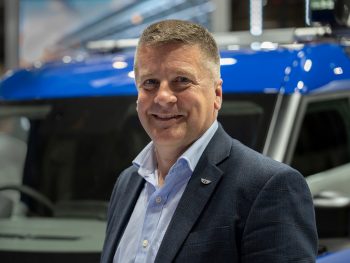LEVC’s James Drake-Lee speaks to VFW about matching customers to the company’s VN5 range-extender van.

The pandemic has not been kind to many companies in the fleet sector and it certainly has not been an easy place for a new company trying to establish a presence in the van market. For LEVC, which launched the VN5 range-extender van, recent months have seen the market pick up as the company sets about building more brand awareness. The company has developed arrangements with vehicle converters and an aftersales network with dealers coming onboard both in Europe and the UK.
“The converter business is really interesting and really useful for organisations wanting vehicles such as fridge vans or racked vans, for instance,” director of narketing and communications James Drake-Lee told Van Fleet World.
“They are operating as quite a useful sales organisation for us because at the end of the day, the customer isn’t interested in buying a van, they are interested in buying a fridge van, or a racked van or a utilities van or whatever it is. We’re really beginning to build up quite a nice head of steam with that group of customers and beginning to build up quite healthy order banks from those individual companies.”
LEVC is selling the VN5 both through a dealer network, which is separate from its taxi sales network and also through direct sales. “It’s really about what’s most appropriate from the customer’s perspective,” says Drake-Lee. “If it’s a smaller operator, the dealer is clearly the right route to market. If it’s a multi-national or national organisation that wants to buy vehicles for a nationwide network, then we will probably talk to them directly. Of course, we own our own dealer in London for both van and taxi.”

A clear pattern of customer for the VN5 is emerging, based on the duty cycle the vehicle will be used for. “It would be wrong to say that our customers are large fleets or small fleets or owner-drivers,” says Drake-Lee. “It’s none of the above, but all of the above. It’s really driven by the use case for their vehicles. So, what we’ll find is there may be large organisations which might have 1,000 vehicles, but for which our vehicle is relevant for a proportion of that, let’s say for example 50 vehicles. Given our small size of business and the fact that we’re selling one model, we don’t expect to be able to cover all the van sizes.
“What we do find is that the use case that works for us is really linked to the range that our vehicle can do because the customers actively want to go ‘green’, actively want to make an environmental statement and actively want to reduce the amount of CO2 they are putting into the atmosphere, but they can’t make use of a battery electric vehicle because it doesn’t have the range, or alternatively the downtime for charging is such that it is too onerous for that business model.”
VN5 customers tend to be those travelling from town to town or city to city, travelling from outside the city, then delivering into the city. It’s a model that LEVC calls distribution to door. “Those organisations are definitely the ones that are all over us and we’re appealing to them in a way that nobody else can,” says Drake-Lee. “BEVs are genuinely great, if your range requirement is simplistically below 100 miles a day.
“If that’s the case, go and buy a BEV every day of the week. That’s your way of being green, it’s the right vehicle for you. Equally, if you want to travel up to Scotland every day, I suggest that you still buy an internal combustion engine vehicle, because nothing else will give you the range to do that length of journey. If you are neither of those but halfway, that’s our distribution-to-door type operation and there’s a really large number of those organisations out there.”

